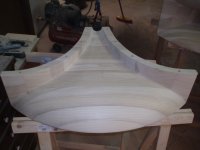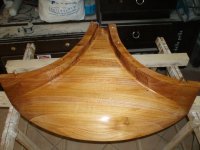Jmmlc and others,
I have a question about the trade off between the largest (300hz) Iwata and the E-Jmlc horns from Autotech.
Horns
Horns
Through the measurements, it appears that the Iwata becomes much more directional in the HF compared to the E-Jmlc. But the Iwata also has fewer ripples in the response.
How would you rate the performance and sound of the Iwata comapred to the E-Jmlc? And would both need supertweeters?
Thanks!
Any thoughts, guys?
Any thoughts, guys?
For what it's worth ...
I have a pair of IWATA 300s mated to a pair of JBL 2446h CDs that are loaded with Truextent Beryllium diaphragms. I am very, very happy with that combination. My listening position is roughly 14 feet from either of them. The IWATAs are 'toed-in' so that you are looking straight at them when at that position. However there is not a bad spot in the room to listen. I can honestly say that this combination is the absolute best and least colored that I have ever heard.
I am using Dirac Live as optimizing EQ and do not have a need for a super tweeter. No harshness and nothing is missing.
Last edited:
I have a IWATA 220 but not JLMC ( old version ) and EJLMC 600.
I use the IWATA 220 for the bass mid and mid with PB 950, the EJLMC 600 with TAD 2001 for the hight mid and treble. and a T925 for higher treble.
No correction.
It's depend of your system part's and configuration.
best regards.
Eric
I use the IWATA 220 for the bass mid and mid with PB 950, the EJLMC 600 with TAD 2001 for the hight mid and treble. and a T925 for higher treble.
No correction.
It's depend of your system part's and configuration.
best regards.
Eric
For purposes of clarity ...
The IWATA 300s that I have are from the first DIY Group buy and are from Autotech.
The IWATA 300s that I have are from the first DIY Group buy and are from Autotech.
Last edited:
This is helpful. Thanks Carl and Eric.
I have a 300 Hz tractrix in front of 2445 CDs, Al diaphragms. More than extension, its the narrowing of the HF that concerns me. The E-JMLC 300 appears to have much wider dispersion than the Iwata 300. It would be helpful to hear the impressions of those that have played with both horns.
I have a 300 Hz tractrix in front of 2445 CDs, Al diaphragms. More than extension, its the narrowing of the HF that concerns me. The E-JMLC 300 appears to have much wider dispersion than the Iwata 300. It would be helpful to hear the impressions of those that have played with both horns.
If the IWATA 300 has a narrowing of HF I don't notice it. But then again age may be having it's way with me one more time!
Age ? It is an interesting question. I can't support separated tweeters any-more, and i feel that more i take years, worse it is. They provide "trebles", separated from the body of the instruments, more a noise than anything else. And if i add them to my horn with an eq, something is wrong with the group delay. You never notice trebles in real instruments.
Well, i use a horn flat up to 16000 hz and i feel-it enough and more natural.
Did-you feel the same ?
Well, i use a horn flat up to 16000 hz and i feel-it enough and more natural.
Did-you feel the same ?
...Did-you feel the same ?
I agree with you. Most of us cannot hear well above 12kHz. Now that I have beryllium diaphragms I realized that what I was complaining about in the past in regards to HF was probably diaphragm breakup when I attempted to flatten response with EQ. The beryllium diaphragms have a similar frequency response but breakup is no longer within the audible band.
12 and 16 kHz is one thing. Horn becoming directional at 3 kHz is another. Subjectively, the narrowing of HF dispersion causes central phantom images to start to form in front of the speaker rather than behind. With wide dispersion in the HF, the scene is more relaxed. Or atleast, I am 🙂
My horns are good enough in directivity that they are crossed at a point half of the distance between the listening point and the line between the cabinets. And you can move lateral with no feeling of change in the tonal balance or localisation.12 and 16 kHz is one thing. Horn becoming directional at 3 kHz is another. Subjectively, the narrowing of HF dispersion causes central phantom images to start to form in front of the speaker rather than behind. With wide dispersion in the HF, the scene is more relaxed. Or atleast, I am 🙂
And one of its main quality is localization both lateral and in distance.
One major advantage of it is the emitting surface is the same at the crossover frequency between the horn and the bass cone, all along with directivity at this frequency, that it is impossible with cones.
Thanks to spherical wave formulas. 🙂
12 and 16 kHz is one thing. Horn becoming directional at 3 kHz is another. Subjectively, the narrowing of HF dispersion causes central phantom images to start to form in front of the speaker rather than behind. With wide dispersion in the HF, the scene is more relaxed. Or atleast, I am 🙂
I have a similar setup, but with JBL 2441s. The biggest value improvement I've done is getting rid of the ineffective JBL damping material in the driver, and replace it with 1/2" denim type (Ultratouch) insulation in the rear chamber. This includes the back side of the chamber and the cylindrical side wall. BIG improvement in that the beaming effect was reduced, as well as other nasties. I was very frustrated with my horns before I did this. It's too inexpensive not to make this improvement.
I found two steps that got rid of most of the directivity and beaming. First when I switch from JBL to TAD there sound stage got out of my face and was building up from around the speakers and backwards. And then when I used Smaart to measure acoustical and fine tune the delay and phase in my electronic crossover filters, the difference was quite amazing. Beaming is gone and dispersion got so much wider that I no longer need to sit in the middle to fully enjoy music. Have quite a few passive crossover networks at diy friends and I must say to optimize a passive filter is a bit harder than building speaker boxes. I will for sure not even try to do use passive filters again. Many of my friends have never heard the maximun performance from their speakers before they switch elements when the filters are maybe the main reasons for their lack of joy.
/Harry
/Harry
It's depnd of configuration again.
The bass mid cut off for one horn for the mid and treble response is very important and crossover's cut off and ranges too.
I used CDS and STF ARTA for the configuration of my sustem. I tried different solutions ( IWATA 220 only, IWATA 220 + T925, IWATA 220 + EJLMC 600, IWATA 220 + EJLMC 600 + T925 ).
I used JLMC 18 db crossover's and 6 db for the tweeter only with no cutt off for EJLMC 600.
Tractrix + EJLMC 600 or IWATA JLMC 600 is a good way.
Eric
The bass mid cut off for one horn for the mid and treble response is very important and crossover's cut off and ranges too.
I used CDS and STF ARTA for the configuration of my sustem. I tried different solutions ( IWATA 220 only, IWATA 220 + T925, IWATA 220 + EJLMC 600, IWATA 220 + EJLMC 600 + T925 ).
I used JLMC 18 db crossover's and 6 db for the tweeter only with no cutt off for EJLMC 600.
Tractrix + EJLMC 600 or IWATA JLMC 600 is a good way.
Eric
Hi superpenna,
The father IWATA ( old, my 220 hz ) is a very good horn ( mesured ), one of the best in the word. This suns ( EJLMC and IWATA JLMC ) have "the same expention curve" with modern otimisations and are in the same way with a + ( mesured for EJLMC 600).
Best regards.
Eric
The father IWATA ( old, my 220 hz ) is a very good horn ( mesured ), one of the best in the word. This suns ( EJLMC and IWATA JLMC ) have "the same expention curve" with modern otimisations and are in the same way with a + ( mesured for EJLMC 600).
Best regards.
Eric
Compared to circular ones ?The father IWATA ( old, my 220 hz ) is a very good horn ( mesured ), one of the best in the word. This suns ( EJLMC and IWATA JLMC ) have "the same expention curve" with modern otimisations and are in the same way with a + ( mesured for EJLMC 600).
Marco,
Your horns are very nice. It is very good work with a lot of précision.
Congratulations.
Chritophe,
Your horns are very nice. It is very good work with a lot of précision.
Congratulations.
Chritophe,
- Home
- Loudspeakers
- Multi-Way
- Jean Michel on LeCleac'h horns

